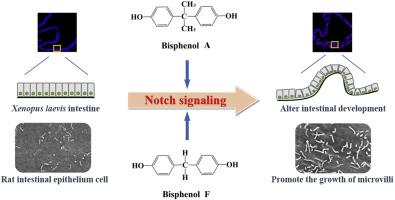当前位置:
X-MOL 学术
›
Environ. Pollut.
›
论文详情
Our official English website, www.x-mol.net, welcomes your feedback! (Note: you will need to create a separate account there.)
Effects of bisphenol A and its alternative bisphenol F on Notch signaling and intestinal development: A novel signaling by which bisphenols disrupt vertebrate development.
Environmental Pollution ( IF 8.9 ) Pub Date : 2020-04-02 , DOI: 10.1016/j.envpol.2020.114443 Min Zhu 1 , Yuanyuan Li 1 , Yue Niu 2 , Jinbo Li 1 , Zhanfen Qin 1
Environmental Pollution ( IF 8.9 ) Pub Date : 2020-04-02 , DOI: 10.1016/j.envpol.2020.114443 Min Zhu 1 , Yuanyuan Li 1 , Yue Niu 2 , Jinbo Li 1 , Zhanfen Qin 1
Affiliation

|
We previously found bisphenol A (BPA) alternative, bisphenol F (BPF) upregulated Notch-related gene expression in intestines of the African clawed frog Xenopus laevis, suggesting an agonistic action on Notch signaling, a crucial signaling in multiple biological processes during development. Here, we aimed to confirm the actions of BPA and BPF on Notch signaling and to reveal their effects on intestinal development. Using X. laevis, an excellent model for developmental biology, we found that 10-1000 nM BPA and BPF significantly elevated Notch-related gene expression in a concentration-dependent manner. Subsequently, exceptional cell proliferation as well as intestinal histological changes were observed in treated intestines. Importantly, Notch inhibitor markedly suppressed the effects of BPA and BPF described above. Furthermore, we employed rat intestinal epithelium cells (IEC-6), an ideal in vitro model of intestinal epithelial cell differentiation, to confirm the effects of bisphenols. As expected, BPA and BPF upregulated Notch-related gene expression and induced the translocation of the Notch intracellular domain to the nucleus, followed by exceptional cell proliferation and differentiation, whereas Notch inhibitor antagonized the effects caused by BPA and BPF. All results strongly demonstrate that both BPA and BPF activate Notch signaling and subsequently disrupt intestinal development in vertebrates. Given its fundamental roles in multiple developmental processes, we propose that Notch signaling is an important and general target signaling of bisphenols in many developing tissues of vertebrates including humans.
中文翻译:

双酚A及其替代双酚F对Notch信号和肠道发育的影响:双酚破坏脊椎动物发育的新型信号。
我们先前发现双酚A(BPA)的替代品,双酚F(BPF)在非洲爪蛙Xenopus laevis的肠中上调了Notch相关基因的表达,暗示了对Notch信号的激动作用,Notch信号是发育过程中多个生物过程中的关键信号。在这里,我们旨在确认BPA和BPF对Notch信号的作用,并揭示它们对肠道发育的影响。使用X.laevis(一种出色的发育生物学模型),我们发现10-1000 nM BPA和BPF以浓度依赖的方式显着提高了Notch相关基因的表达。随后,在处理过的肠道中观察到异常的细胞增殖以及肠道组织学变化。重要的是,Notch抑制剂显着抑制了上述BPA和BPF的作用。此外,我们使用大鼠肠上皮细胞(IEC-6)(一种理想的肠上皮细胞分化体外模型)来证实双酚的作用。正如预期的那样,BPA和BPF上调了Notch相关基因的表达并诱导了Notch细胞内结构域向核的转运,随后异常的细胞增殖和分化,而Notch抑制剂拮抗了BPA和BPF引起的作用。所有结果都强烈证明BPA和BPF均激活Notch信号传导,并随后破坏脊椎动物的肠道发育。鉴于其在多种发育过程中的基本作用,我们提出,Notch信号传导是包括人类在内的许多脊椎动物发育组织中双酚的重要且普遍的目标信号传导。理想的肠上皮细胞分化体外模型,以证实双酚的作用。正如预期的那样,BPA和BPF上调了Notch相关基因的表达并诱导了Notch细胞内结构域向核的转运,随后异常的细胞增殖和分化,而Notch抑制剂拮抗了BPA和BPF引起的作用。所有结果都强烈证明BPA和BPF均激活Notch信号传导,并随后破坏脊椎动物的肠道发育。鉴于其在多种发育过程中的基本作用,我们提出,Notch信号传导是包括人类在内的许多脊椎动物发育组织中双酚的重要且普遍的目标信号传导。理想的肠上皮细胞分化体外模型,以证实双酚的作用。正如预期的那样,BPA和BPF上调了Notch相关基因的表达并诱导了Notch细胞内结构域向核的转运,随后异常的细胞增殖和分化,而Notch抑制剂拮抗了BPA和BPF引起的作用。所有结果都强烈证明BPA和BPF均激活Notch信号传导,并随后破坏脊椎动物的肠道发育。鉴于其在多种发育过程中的基本作用,我们提出,Notch信号传导是包括人类在内的许多脊椎动物发育组织中双酚的重要且普遍的目标信号传导。BPA和BPF上调了Notch相关基因的表达并诱导了Notch细胞内结构域向核的转运,随后异常的细胞增殖和分化,而Notch抑制剂拮抗了BPA和BPF引起的作用。所有结果都强烈证明BPA和BPF均激活Notch信号传导,并随后破坏脊椎动物的肠道发育。鉴于其在多种发育过程中的基本作用,我们提出,Notch信号传导是包括人类在内的许多脊椎动物组织中双酚的重要且普遍的目标信号传导。BPA和BPF上调了Notch相关基因的表达并诱导了Notch细胞内结构域向核的转运,随后异常的细胞增殖和分化,而Notch抑制剂拮抗了BPA和BPF引起的作用。所有结果都强烈证明BPA和BPF均激活Notch信号传导,并随后破坏脊椎动物的肠道发育。鉴于其在多种发育过程中的基本作用,我们提出,Notch信号传导是包括人类在内的许多脊椎动物组织中双酚的重要且普遍的目标信号传导。而Notch抑制剂可拮抗BPA和BPF引起的作用。所有结果都强烈证明BPA和BPF均激活Notch信号传导,并随后破坏脊椎动物的肠道发育。鉴于其在多种发育过程中的基本作用,我们提出,Notch信号传导是包括人类在内的许多脊椎动物发育组织中双酚的重要且通用的目标信号传导。而Notch抑制剂可拮抗BPA和BPF引起的作用。所有结果都强烈证明BPA和BPF均激活Notch信号传导,并随后破坏脊椎动物的肠道发育。鉴于其在多种发育过程中的基本作用,我们提出,Notch信号传导是包括人类在内的许多脊椎动物组织中双酚的重要且普遍的目标信号传导。
更新日期:2020-04-20
中文翻译:

双酚A及其替代双酚F对Notch信号和肠道发育的影响:双酚破坏脊椎动物发育的新型信号。
我们先前发现双酚A(BPA)的替代品,双酚F(BPF)在非洲爪蛙Xenopus laevis的肠中上调了Notch相关基因的表达,暗示了对Notch信号的激动作用,Notch信号是发育过程中多个生物过程中的关键信号。在这里,我们旨在确认BPA和BPF对Notch信号的作用,并揭示它们对肠道发育的影响。使用X.laevis(一种出色的发育生物学模型),我们发现10-1000 nM BPA和BPF以浓度依赖的方式显着提高了Notch相关基因的表达。随后,在处理过的肠道中观察到异常的细胞增殖以及肠道组织学变化。重要的是,Notch抑制剂显着抑制了上述BPA和BPF的作用。此外,我们使用大鼠肠上皮细胞(IEC-6)(一种理想的肠上皮细胞分化体外模型)来证实双酚的作用。正如预期的那样,BPA和BPF上调了Notch相关基因的表达并诱导了Notch细胞内结构域向核的转运,随后异常的细胞增殖和分化,而Notch抑制剂拮抗了BPA和BPF引起的作用。所有结果都强烈证明BPA和BPF均激活Notch信号传导,并随后破坏脊椎动物的肠道发育。鉴于其在多种发育过程中的基本作用,我们提出,Notch信号传导是包括人类在内的许多脊椎动物发育组织中双酚的重要且普遍的目标信号传导。理想的肠上皮细胞分化体外模型,以证实双酚的作用。正如预期的那样,BPA和BPF上调了Notch相关基因的表达并诱导了Notch细胞内结构域向核的转运,随后异常的细胞增殖和分化,而Notch抑制剂拮抗了BPA和BPF引起的作用。所有结果都强烈证明BPA和BPF均激活Notch信号传导,并随后破坏脊椎动物的肠道发育。鉴于其在多种发育过程中的基本作用,我们提出,Notch信号传导是包括人类在内的许多脊椎动物发育组织中双酚的重要且普遍的目标信号传导。理想的肠上皮细胞分化体外模型,以证实双酚的作用。正如预期的那样,BPA和BPF上调了Notch相关基因的表达并诱导了Notch细胞内结构域向核的转运,随后异常的细胞增殖和分化,而Notch抑制剂拮抗了BPA和BPF引起的作用。所有结果都强烈证明BPA和BPF均激活Notch信号传导,并随后破坏脊椎动物的肠道发育。鉴于其在多种发育过程中的基本作用,我们提出,Notch信号传导是包括人类在内的许多脊椎动物发育组织中双酚的重要且普遍的目标信号传导。BPA和BPF上调了Notch相关基因的表达并诱导了Notch细胞内结构域向核的转运,随后异常的细胞增殖和分化,而Notch抑制剂拮抗了BPA和BPF引起的作用。所有结果都强烈证明BPA和BPF均激活Notch信号传导,并随后破坏脊椎动物的肠道发育。鉴于其在多种发育过程中的基本作用,我们提出,Notch信号传导是包括人类在内的许多脊椎动物组织中双酚的重要且普遍的目标信号传导。BPA和BPF上调了Notch相关基因的表达并诱导了Notch细胞内结构域向核的转运,随后异常的细胞增殖和分化,而Notch抑制剂拮抗了BPA和BPF引起的作用。所有结果都强烈证明BPA和BPF均激活Notch信号传导,并随后破坏脊椎动物的肠道发育。鉴于其在多种发育过程中的基本作用,我们提出,Notch信号传导是包括人类在内的许多脊椎动物组织中双酚的重要且普遍的目标信号传导。而Notch抑制剂可拮抗BPA和BPF引起的作用。所有结果都强烈证明BPA和BPF均激活Notch信号传导,并随后破坏脊椎动物的肠道发育。鉴于其在多种发育过程中的基本作用,我们提出,Notch信号传导是包括人类在内的许多脊椎动物发育组织中双酚的重要且通用的目标信号传导。而Notch抑制剂可拮抗BPA和BPF引起的作用。所有结果都强烈证明BPA和BPF均激活Notch信号传导,并随后破坏脊椎动物的肠道发育。鉴于其在多种发育过程中的基本作用,我们提出,Notch信号传导是包括人类在内的许多脊椎动物组织中双酚的重要且普遍的目标信号传导。


























 京公网安备 11010802027423号
京公网安备 11010802027423号